
Why Paul chose Ibanez in particular to produce his first signature guitar isn't exactly clear. Perhaps he truly had enjoyed his Ibanez Destroyer. Perhaps he had finally understood what kind of plan Gibson had for their sponsorship deal, a deal that evidently was about to run out in 1977. Perhaps he, like many others, felt that Gibson has betrayed their once high standards of production in the 70's. Or perhaps he wasn't really giving it much thought, although one would forgive that kind of hubris from a man fronting on of the most well-known band in America, until he was contacted by Ibanez during the band's first trip to Japan in the spring on 1977.
"[W]hen we went to Tokyo, it was absolute bedlam. We couldn't leave the hotel, there was a mob/riot at the airport. Ibanez called and said they wanted to get together with me with the idea of making a guitar, a signature guitar" (Guitars that Rule the World in Metal Edge presents KISS Alive 1996) Although the original idea seems to have been that Paul was to design a completely new guitar that didn't come to fruition. "When I looked through their catalog, I saw a picture of a guitar that was not terribly popular. I liked the asymmetrical shape to it; it reminded me of a Firebird or a Rickenbacker bass turned upside down. It had one pickup one it that looked like you took three bobbins from a humbucker and put them together somehow. It also had that whacky knob that looked like you were going to change your television channels with it." (Guitar Shop, October 1996)
The guitar Paul is referring to is almost surely the Artist 2663TC. Introduced in the 1976 Ibanez Artist catalog as seen above, the shape now commonly known as the Iceman was just another model in the Artist line. The "whacky knob" that Paul refers to is the chicken-head knob that was a "4 position tone selector switch". One wonders if Paul remembers the distinct tail piece as well. Paul has mentioned that he and Ibanez produced a number of prototypes (again in the Metal Edge article quoted above) and by my count there were three as seen below. A Japanese site has claimed that the first prototype was finished while Paul was still in Japan but that seems to be a very short window for Ibanez and Paul to first sit down, toss around some design ideas, decide on the shape, and produce a prototype guitar - and all this in just over 14 days. Considering that the demands on Paul's time wasn't limited to just rehearsing for and playing shows but also promotional work it seems a bit rushed. What does seem clear is both parties came to an agreement on the matter because Ibanez was quick to use Paul's name in relation to its newly christened Iceman line. For the first appearance of the Iceman in the 1977 Ibanez Performer foldout catalog there's no mention of Paul but in the poster catalog later that year ("Tomorrow's name in guitars") both Paul and Steve Miller are name-dropped. Interestingly enough the latter catalog also see the disappearance of the last remains of the old Artist "Iceman" as the IC-210, the 1977 version of the Artist 2663TC, is quietly dropped.
"[W]hen we went to Tokyo, it was absolute bedlam. We couldn't leave the hotel, there was a mob/riot at the airport. Ibanez called and said they wanted to get together with me with the idea of making a guitar, a signature guitar" (Guitars that Rule the World in Metal Edge presents KISS Alive 1996) Although the original idea seems to have been that Paul was to design a completely new guitar that didn't come to fruition. "When I looked through their catalog, I saw a picture of a guitar that was not terribly popular. I liked the asymmetrical shape to it; it reminded me of a Firebird or a Rickenbacker bass turned upside down. It had one pickup one it that looked like you took three bobbins from a humbucker and put them together somehow. It also had that whacky knob that looked like you were going to change your television channels with it." (Guitar Shop, October 1996)
The guitar Paul is referring to is almost surely the Artist 2663TC. Introduced in the 1976 Ibanez Artist catalog as seen above, the shape now commonly known as the Iceman was just another model in the Artist line. The "whacky knob" that Paul refers to is the chicken-head knob that was a "4 position tone selector switch". One wonders if Paul remembers the distinct tail piece as well. Paul has mentioned that he and Ibanez produced a number of prototypes (again in the Metal Edge article quoted above) and by my count there were three as seen below. A Japanese site has claimed that the first prototype was finished while Paul was still in Japan but that seems to be a very short window for Ibanez and Paul to first sit down, toss around some design ideas, decide on the shape, and produce a prototype guitar - and all this in just over 14 days. Considering that the demands on Paul's time wasn't limited to just rehearsing for and playing shows but also promotional work it seems a bit rushed. What does seem clear is both parties came to an agreement on the matter because Ibanez was quick to use Paul's name in relation to its newly christened Iceman line. For the first appearance of the Iceman in the 1977 Ibanez Performer foldout catalog there's no mention of Paul but in the poster catalog later that year ("Tomorrow's name in guitars") both Paul and Steve Miller are name-dropped. Interestingly enough the latter catalog also see the disappearance of the last remains of the old Artist "Iceman" as the IC-210, the 1977 version of the Artist 2663TC, is quietly dropped.
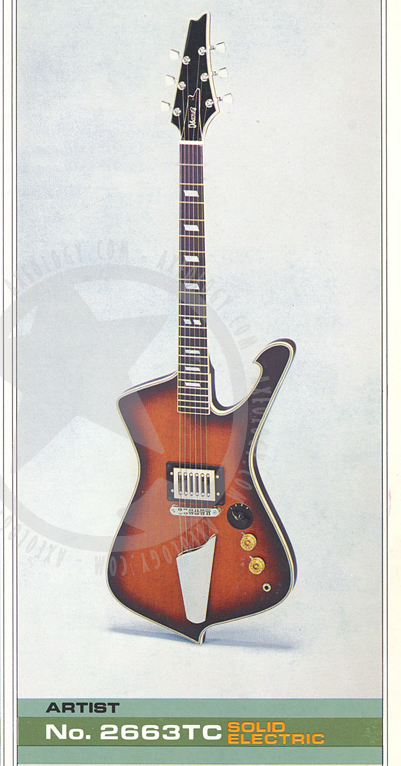
[Above] The 1976 Artists 2663TC that was the template for the later PS10. Note the "whacky knob", the triple-coil pickup, and the elaborate tailpiece.
What is supposedly the first prototype PS10 surfaced in an eBay auction in 2002. The
pedigree of that guitar is unproven as far as I know and the assertion in the auction that Paul actually used it on stage has certainly never been verified. The look of the guitar and the details of it don't clearly tilt the scales in either direction though.
I'll start with the details that I think come out against this being a "true" first prototype of the PS10. First of all, no Artist or Iceman guitars I have seen from 1976-77 had the Ibanez logo on the headstock itself, it was always printed on the truss rod cover. The mirror truss rod cover on this prototype overlaps the Ibanez logo on the headstock which seems very odd considering that the truss rod cover shape and size is exactly the same as it had been since the Artist "Iceman" was introduced in 1976. Add to that the fact that none of Paul's later 1977 protoypes had a signature truss rod cover, that didn't really show up until the catalog version of the PS10 appeared in 1978, and it leads me to believe that at least the truss rod cover was added by a seller at a later date. The placement and spacing of the control knobs on this guitar more closely mirrors that of the 1978 catalog PS10 rather than the later 1977 prototypes Paul had but that's hardly a clincher; Paul could have tried both and ultimately decided on one or the other. (And he did, in fact, try two different placements on the prototypes he used live.)
pedigree of that guitar is unproven as far as I know and the assertion in the auction that Paul actually used it on stage has certainly never been verified. The look of the guitar and the details of it don't clearly tilt the scales in either direction though.
I'll start with the details that I think come out against this being a "true" first prototype of the PS10. First of all, no Artist or Iceman guitars I have seen from 1976-77 had the Ibanez logo on the headstock itself, it was always printed on the truss rod cover. The mirror truss rod cover on this prototype overlaps the Ibanez logo on the headstock which seems very odd considering that the truss rod cover shape and size is exactly the same as it had been since the Artist "Iceman" was introduced in 1976. Add to that the fact that none of Paul's later 1977 protoypes had a signature truss rod cover, that didn't really show up until the catalog version of the PS10 appeared in 1978, and it leads me to believe that at least the truss rod cover was added by a seller at a later date. The placement and spacing of the control knobs on this guitar more closely mirrors that of the 1978 catalog PS10 rather than the later 1977 prototypes Paul had but that's hardly a clincher; Paul could have tried both and ultimately decided on one or the other. (And he did, in fact, try two different placements on the prototypes he used live.)
In the pros column we find the following. The body of this prototype has the recessed lower strap button of the original Artists, the Iceman had more of a slab style body, and using an existing body makes sense. In addition, the Artist series never had dot inlays; their inlays were all parallelograms. So this pairing shouldn't exist and although it's obviously not unheard of to replace a fretboard it seem an unlikely move, especially since a fretboard from a proper PS10 with the pearl/abalone split inlays might look more "legit". (I'll come back to the reason for this later.) The very unusual tail piece is something that appears on no other Ibanez guitars. In the 1976 and 1977 catalogs the Gibraltar bridge is paired with either the original Quik-Change or the Quik-Change II tail piece (the difference being that the latter had angled slots). The curved tail piece/mirror combo on this prototype looks as if it was designed only to cover the routing of the Artist models, a routing that accommodated the rather exuberant tail piece they had. The binding is also an issue - this guitar has triple-layer binding while both the Artist and the Iceman had single-layer. Lastly, this prototype has the output jack on the side of the body which neither the Artists nor the Iceman of the time had. (Of course, this is a relatively easy modification to make for a good luthier.) Regardless of the pedigree or lack thereof I'm going to call this hybrid prototype #1. (Henceforth I'll adopt the shorthand of PT for prototype.)
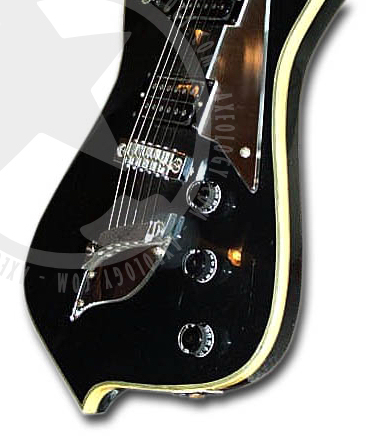

[Right] The recessed lower strap button of PT#1, just like the earlier Artists models.
The first time Paul actually shows up with a PS10 (although it wasn't called that just
yet) is for the photo shoot and later show in San Diego, CA on August 19. In fact, for
this photo shoot he brings two prototypes: for the solo shots he uses the second prototype (PT#"2) and for the group shots he brings out the third prototype (PT#3). (Since they both appear on the same date the #2 and #3 designation is based on how much use they got during 1977.) But before we get into that, let's discuss the inlays. Paul has claimed that he decided or designed just about everything about the PS10: "I picked frets I liked, designed inlays for the fingerboard, and really built the guitar from the ground up". (GTRTW) The problem with that statement is that the, admittedly gorgeous, pearl/abalone split block inlays of the stage-played prototypes and the catalog PS10 had been around since 1976 and appears on a number of models in both the '76 and '77 catalogs. The George Benson signature model used them for instance and that model also seems to have been Ibanez's first to feature the "name inlay" at the 21st fret that later appeared on the PS10. This second prototype (PT#2) has the pearl/abalone split block inlays and the "name" inlay but for some odd reason the latter appears on the 22nd fret leaving a strange 2-fret gap between inlays.
As for the rest, let's start from the top. Unlike PT#1 and the later production PS10, PT#2 looks as if it only has single-layer binding on the headstock. PT#2 has chrome Grover tuners (or possibly Ibanez's Smooth Tuner with chrome heads). Although hard to see in some pics the truss rod cover seems to be black plastic with the Ibanez logo
printed in white. The pickups have chrome pickup covers so it appears that Paul might initially have tried regular Ibanez pickups. The pickguard has the same shape and size as the one on the production PS10 but in most photographs this one appears to be made of high-gloss black plastic, it certainly doesn't reflect light even remotely like the chrome pickup covers do in photographs. The placement of the volume knob is the same as on PT#1 but the spacing of the knobs is much narrower which leaves a lot more room between the third knob and the edge of the body.
yet) is for the photo shoot and later show in San Diego, CA on August 19. In fact, for
this photo shoot he brings two prototypes: for the solo shots he uses the second prototype (PT#"2) and for the group shots he brings out the third prototype (PT#3). (Since they both appear on the same date the #2 and #3 designation is based on how much use they got during 1977.) But before we get into that, let's discuss the inlays. Paul has claimed that he decided or designed just about everything about the PS10: "I picked frets I liked, designed inlays for the fingerboard, and really built the guitar from the ground up". (GTRTW) The problem with that statement is that the, admittedly gorgeous, pearl/abalone split block inlays of the stage-played prototypes and the catalog PS10 had been around since 1976 and appears on a number of models in both the '76 and '77 catalogs. The George Benson signature model used them for instance and that model also seems to have been Ibanez's first to feature the "name inlay" at the 21st fret that later appeared on the PS10. This second prototype (PT#2) has the pearl/abalone split block inlays and the "name" inlay but for some odd reason the latter appears on the 22nd fret leaving a strange 2-fret gap between inlays.
As for the rest, let's start from the top. Unlike PT#1 and the later production PS10, PT#2 looks as if it only has single-layer binding on the headstock. PT#2 has chrome Grover tuners (or possibly Ibanez's Smooth Tuner with chrome heads). Although hard to see in some pics the truss rod cover seems to be black plastic with the Ibanez logo
printed in white. The pickups have chrome pickup covers so it appears that Paul might initially have tried regular Ibanez pickups. The pickguard has the same shape and size as the one on the production PS10 but in most photographs this one appears to be made of high-gloss black plastic, it certainly doesn't reflect light even remotely like the chrome pickup covers do in photographs. The placement of the volume knob is the same as on PT#1 but the spacing of the knobs is much narrower which leaves a lot more room between the third knob and the edge of the body.

And then we have the third prototype (PT#3). Like PT#2 it has chrome Grover-style tuning pegs. The truss rod cover, however, appears to be silvery or matte gray rather than mirror or black plastic and has what looks like a gold Ibanez logo. This is better seen in this closeup from San Diego and in a live shot from Los Angeles, CA on August 26. Looking at the end of the fretboard there is also a distinct lack of the "name" inlay. In this pic from August 28 we see both the silvery look of the truss rod cover and the fact that PT#3 has the pearl/abalone split block inlay at the 21st fret and a distinct lack of a "name" inlay. In the previous pic and the one on the right (click for a larger version) we can also see that the tail piece is located much farther back on the body of the guitar than on PT#2 or the PS10. Although not immediately evident, the volume knob on PT#3 is located in line with the top of the Gibraltar bridge which has necessitated a different and quite distinct shape for the pickguard to accommodate that placement. The pic on the right shows this little "curve" around the volume knob clearly.
The features that both PT#2 and PT#3 share with the production PS10 are the pearl/abalone split block inlays, the rather elaborate 7-layer body binding with an abalone center, and the mirror "burst" below the Quik-Change tailpiece.
The features that both PT#2 and PT#3 share with the production PS10 are the pearl/abalone split block inlays, the rather elaborate 7-layer body binding with an abalone center, and the mirror "burst" below the Quik-Change tailpiece.

The original Ibanez pickups with chrome covers didn't last long. "Ibanez just made a couple of new ones, because I wasn't happy with the earliest pickups- they didn't cut it." (Guitar Player 1978) Whether or not these new Ibanez pickups are the ones that show up for the photo shoot with Lynn Goldsmith on November 9 or not is anybody's guess. The picture shown here on the left shows PT#2 with exposed coils. We also get a very close look at the odd inlay at the 22nd fret and the narrow placement of the control knobs.
A picture from this photo shoot is also used for the very first Ibanez ad for the upcoming Paul Stanley model. It's unclear whether this ad appeared in late 1977 or early 1978 but it's interesting to note that the model name of the guitar in the ad is IC-1000. This would have made it the top-of-the-line of the Iceman line but as we all know this was soon changed to the PS10. One can presume that Paul had a say in the matter since he's repeatedly stated that the PS10 and the Iceman are completely different guitars. "Onstage I'm using an Ibanez Paul Stanley model. It's very much like their Ice Man [sic.], but construction-wise it's different. It has a mahogany body with a maple neck and ebony finger-board." (Guitar Player 1978) "[T]he Iceman and the PS10 has about as much in common as a Chevy and a Rolls Royce." (Guitar Shop, October 1996)
Although the pictures from their first appearance in San Diego show that PT#3 served as the main guitar, PT#2 has a capo and was probably only used for Hooligan, the available photographs from the rest of 1977 appear to show that PT#2 is actually the clear favorite. It shows up time and again while PT#3 is very clearly absent. On November 26 in Tulsa, OK the 22nd fret inlay of PT#2 is very much on display. A few weeks later in New York, NY on December 14 we see it again.
A picture from this photo shoot is also used for the very first Ibanez ad for the upcoming Paul Stanley model. It's unclear whether this ad appeared in late 1977 or early 1978 but it's interesting to note that the model name of the guitar in the ad is IC-1000. This would have made it the top-of-the-line of the Iceman line but as we all know this was soon changed to the PS10. One can presume that Paul had a say in the matter since he's repeatedly stated that the PS10 and the Iceman are completely different guitars. "Onstage I'm using an Ibanez Paul Stanley model. It's very much like their Ice Man [sic.], but construction-wise it's different. It has a mahogany body with a maple neck and ebony finger-board." (Guitar Player 1978) "[T]he Iceman and the PS10 has about as much in common as a Chevy and a Rolls Royce." (Guitar Shop, October 1996)
Although the pictures from their first appearance in San Diego show that PT#3 served as the main guitar, PT#2 has a capo and was probably only used for Hooligan, the available photographs from the rest of 1977 appear to show that PT#2 is actually the clear favorite. It shows up time and again while PT#3 is very clearly absent. On November 26 in Tulsa, OK the 22nd fret inlay of PT#2 is very much on display. A few weeks later in New York, NY on December 14 we see it again.



[Above] PT#2 live in San Diego. Although not super-sharp the pic shows the 22nd fret inlay. Click for a larger version. Uncropped picture available from www.photosets.net
[Right] PT#3 live in San Diego. Note the distinct shape of the pickguard. Click for a larger version. Uncropped picture available from www.photosets.net
[Above] PT#2 during the rehearsals for the Alive II Tour (Lynn Goldsmith photo). Note the 22nd fret inlay and the black pickguard, both details specific to this particular guitar.
For KISS, the beginning of a new year was not the dividing chasm it had once been, the Alive II Tour continued more or less uninterrupted into 1978 and as it wore on PT#2 was still the hands-down favorite of the two prototypes. On the right we see it in Cleveland, OH on January 8. Even if my collection of pictures is relatively meager the fact that PT#3 is almost entirely absent during this last leg of the Alive II tour speaks volumes: Paul had found his preferred guitar and stuck with it. The only photo I have of PT#3 during this time is this one from Detroit, MI on January 20 which is less than stellar when it comes to revealing details. It does look like it has the 21st fret inlay and the curve of the lower end of the pickguard to accomodate the placement of the volume knob.
It's not until the band make their second trip to Japan in March-April that we can be sure that PT#3 shows up again, as seen in this pic from March 28 in Osaka, and even then it's obviously in the role of "reliever". (PT#3 will receive its fair due but that's many years later.) The majority of the pictures from the shows in Japan show PT#2 carrying the load and there are plenty of backstage pics like this one from the 1978 Music Life Special (p. 146), taken just before the band is set to hit the stage as evidenced by Peter's lack of platforms. It makes its "last" appearance in Valencia, CA in May for the taping of the live scenes for KISS Meets the Phantom of the Park.
The reason for the disappearance of the prototypes from live use is simple, they had done their job. In the 1978 Ibanez catalogue the PS10 makes its debut looking, more or less, like PT#2 with a mirror pickguard and the name inlay at the 21st fret. After the comparatively long break from touring following the Alive II tour a number of "factory" PS10's take the stage...
It's not until the band make their second trip to Japan in March-April that we can be sure that PT#3 shows up again, as seen in this pic from March 28 in Osaka, and even then it's obviously in the role of "reliever". (PT#3 will receive its fair due but that's many years later.) The majority of the pictures from the shows in Japan show PT#2 carrying the load and there are plenty of backstage pics like this one from the 1978 Music Life Special (p. 146), taken just before the band is set to hit the stage as evidenced by Peter's lack of platforms. It makes its "last" appearance in Valencia, CA in May for the taping of the live scenes for KISS Meets the Phantom of the Park.
The reason for the disappearance of the prototypes from live use is simple, they had done their job. In the 1978 Ibanez catalogue the PS10 makes its debut looking, more or less, like PT#2 with a mirror pickguard and the name inlay at the 21st fret. After the comparatively long break from touring following the Alive II tour a number of "factory" PS10's take the stage...


[Right] PT#2 live in Cleveland, OH 78.01.08, 22nd fret inlay clearly on display.

After more than a year off from touring the band and its management, awash in the hubris of the mega-success of the previous two years, set about creating the greatest spectacle they could conceive. Upgrading the members of a run-of-the-mill rock band to icons with a hint of superhero was just the start; there was to be a new stage with 360-degree visibility (something Ace mentioned as early as December 1978) and new gimmicks and stage tricks for all. Although most of the new tricks and effects like the laser curtain or Paul's eye laser never came to fruition, there were still plenty of visuals to go with the usual ear-splitting volume. The drum riser was taller and, although considerably less sensational these days, in 1979 Gene's flying had to have been impossibly cool and awesome. This focus on the spectacular also resulted in one of Paul's guitars being reduced to little more than a prop, albeit one of the more iconic props in KISStory.
By this time the PS10 had become a production guitar, first appearing in the 1978 Ibanez catalog. The finish options of the PS10 were decidedly limited though (it was the model T Ford of guitars, you could get any color as long as it was black), and Paul had something considerably more spectacular in mind. "My mirror Iceman guitar [sic.] was actually not a unique or original idea. Noddy [Holder of Slade] had a top hat with these huge circle mirrors on it. So when they hit Noddy's top hat [with a spotlight] these beams of light came out of his head." (Nothin' to lose by Ken Sharp, p. 311) "It was really cool and the mirror-ball effect we were using in shows was also cool, so why not fracture a mirror on the face of the guitar, but make sure that each facet is offset from the neck so that when the lights hits it you have hundreds of lights shining out of the guitar." (Guitar Shop, October 1996)
By this time the PS10 had become a production guitar, first appearing in the 1978 Ibanez catalog. The finish options of the PS10 were decidedly limited though (it was the model T Ford of guitars, you could get any color as long as it was black), and Paul had something considerably more spectacular in mind. "My mirror Iceman guitar [sic.] was actually not a unique or original idea. Noddy [Holder of Slade] had a top hat with these huge circle mirrors on it. So when they hit Noddy's top hat [with a spotlight] these beams of light came out of his head." (Nothin' to lose by Ken Sharp, p. 311) "It was really cool and the mirror-ball effect we were using in shows was also cool, so why not fracture a mirror on the face of the guitar, but make sure that each facet is offset from the neck so that when the lights hits it you have hundreds of lights shining out of the guitar." (Guitar Shop, October 1996)
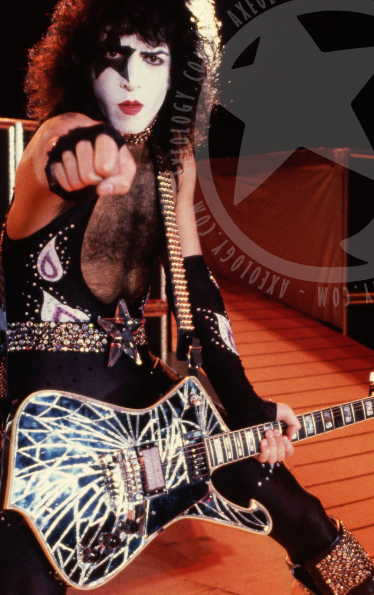
[Left] SM#1 during the photo shoot in Lakeland, FL. The show planned for the date was cancelled, supposedly because Peter Criss required additional rest.

The unenviable task of realizing Paul's vision fell to Jeff Hasselberger of Ibanez USA. Jeff's initial attempt, actually smashing a mirror shaped like a PS10, didn't work very well: "I ended up with 10,000 bits of mirror dust and about three other pieces". (Guitar World centerfold, 1992) In order to get the desired look Jeff eventually cut each piece by hand, pretty much cutting pieces "that I thought looked cool", which took a couple of days. During this time Jim Heffner, also of Ibanez USA, had routed out a quarter-inch of the maple top on a PS10. "We routed out twice the thickness of the mirror so we could set each piece at a slightly different angle, Paul's stage concept was to hit the guitar with a Super Trooper spot light and have rays of light shooting out from the guitar at all angles like a mirror ball. We figured a 5 to 15 degree difference between adjoining pieces would do it." (Vintage Guitar, September 1994)
Since cut pieces of glass has the rather impractical tendency to have sharp edges the original idea was to coat the entire top with clear polyurethane. "I mixed up the polyurethane and poured it on. I went about my business for a few hours and when I went back to the shop to check it, my stomach knotted. It was drying cloudy and ruining the whole mirror effect. Shit! Now what? Before it got rock hard, I took a chisel and began to scrape the finish off. Fortunately, glass doesn't hold finish very well, and by dinner time I had removed nearly all the finish." (Vintage Guitar, September 1994) Since this left the edges still sharp Hasselberger sanded the edges smooth using a "small sanding wheel on a Dremel tool". (Guitar World centerfold, 1992) Some edges were evidently not entirely smooth as Paul mentioned later: "[I]f you look at it closely there's some spots under the mirror where there's old blood. I cut my fingers a few times, so now all the corners have been filed down." (GTRTW)
Since cut pieces of glass has the rather impractical tendency to have sharp edges the original idea was to coat the entire top with clear polyurethane. "I mixed up the polyurethane and poured it on. I went about my business for a few hours and when I went back to the shop to check it, my stomach knotted. It was drying cloudy and ruining the whole mirror effect. Shit! Now what? Before it got rock hard, I took a chisel and began to scrape the finish off. Fortunately, glass doesn't hold finish very well, and by dinner time I had removed nearly all the finish." (Vintage Guitar, September 1994) Since this left the edges still sharp Hasselberger sanded the edges smooth using a "small sanding wheel on a Dremel tool". (Guitar World centerfold, 1992) Some edges were evidently not entirely smooth as Paul mentioned later: "[I]f you look at it closely there's some spots under the mirror where there's old blood. I cut my fingers a few times, so now all the corners have been filed down." (GTRTW)


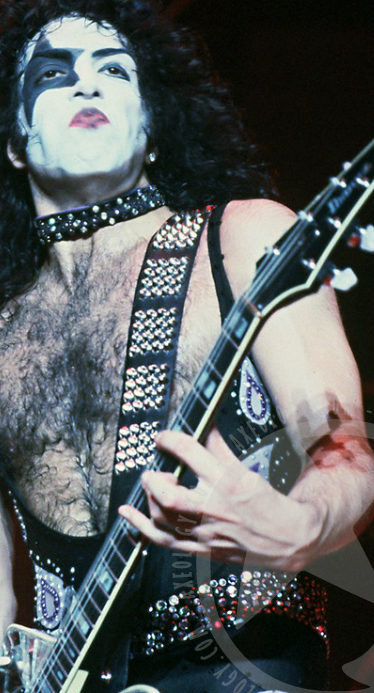
Once promo shots and touring began this modified PS10 which I will call SM#1 (for Shattered Mirror) is Paul's main guitar. The many small details that set it apart from a standard PS10 production model makes me believe that this might be a 4th prototype built for Paul or at the very least a complete custom shop job. Apart from the top it had a replacement bridge pickup, most probably a DiMarzio Super II (although it bears a striking resemblance to the neck pickup of the Marauder), while it retained what looks like a standard PAF-type humbucker with a chrome pickup cover in the neck position (not at all dissimilar from the pickups that were first in PT#2 and 3). This differed from the production model which had two exposed-coil V-2 humbuckers. The truss rod cover also lacked the signature and looked to be made of black plastic.
Quite unlike the production model SM#1 also had single-ply binding on the headstock as seen in the Bob Alford pic from Pembroke Pines, FL on the left. Here we also see the brass nut which, again, is different from the production PS10 which had a half brass/half bone nut. (In the interest of clarity I feel obliged to flatly state that SM#1 is most assuredly not a modification of either PT#2 or #3; SM#1 is a completely different guitar as evidence that will be revealed a little later will testify.)
Even the tailpiece is different, the SM#1 sporting a Quick-Change (spare part no. 227 in the 1980 parts catalogue) with angled slots while the regular PS10 had the straight-slot Gibraltar tailpiece (no. 226). The control knobs are set closer together than on the production model and the volume knob is located ever slightly farther back relative to the bridge, about half a knob's width actually (as seen here). Just about the only thing "production" about the SM#1 are the Velve-Tune "notch" style pearloid tuners. And those don't last long...
(In some early pics the pickguard looks almost black and non-reflective but that's just angles and the play of light. This pic from Pembroke Pines, FL on 79.06.17 clearly shows Paul's fingers reflected in the pickguard.)
Quite unlike the production model SM#1 also had single-ply binding on the headstock as seen in the Bob Alford pic from Pembroke Pines, FL on the left. Here we also see the brass nut which, again, is different from the production PS10 which had a half brass/half bone nut. (In the interest of clarity I feel obliged to flatly state that SM#1 is most assuredly not a modification of either PT#2 or #3; SM#1 is a completely different guitar as evidence that will be revealed a little later will testify.)
Even the tailpiece is different, the SM#1 sporting a Quick-Change (spare part no. 227 in the 1980 parts catalogue) with angled slots while the regular PS10 had the straight-slot Gibraltar tailpiece (no. 226). The control knobs are set closer together than on the production model and the volume knob is located ever slightly farther back relative to the bridge, about half a knob's width actually (as seen here). Just about the only thing "production" about the SM#1 are the Velve-Tune "notch" style pearloid tuners. And those don't last long...
(In some early pics the pickguard looks almost black and non-reflective but that's just angles and the play of light. This pic from Pembroke Pines, FL on 79.06.17 clearly shows Paul's fingers reflected in the pickguard.)

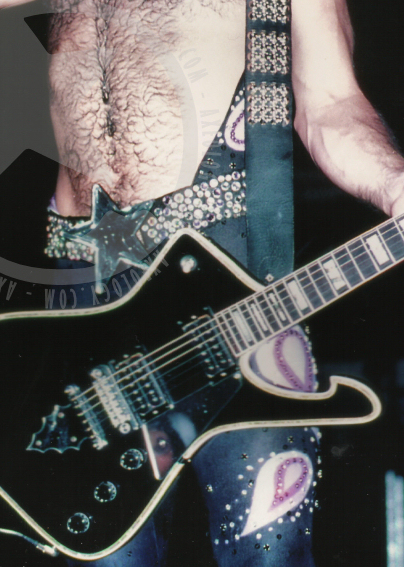
But before we dive head first into another dizzying run of minor modifications it's best to take a quick look at the backups. Far be it from Paul to tour using only one guitar so for the early stages of the Return of KISS Tour he had two more "standard" PS10's in tow. These do appear more or less like the production models; neither one has that tell-tale grayish Super II humbucker that Paul favored and both feature the straight-slot Gibraltar tailpiece. Even the knob spacing, not to mention the stock Speed knobs, are straight out of the Ibanez catalogue. But true to his usual practice (see the Flying V's and the 1979 Hamers) they differed ever so slightly to allow him, and his tech, to easily tell them apart.
The first suspect to show up (PS10A) is this from Cleveland, OH on July 19. This particular PS10 has Grover Rotomatic "milk bottle" tuners, sometimes called banjo-style tuners, and considering the use of a capo at the 1st fret it was almost certainly used for Makin' love which made a few appearances in the setlist. The second backup (PS10B) had regular "notch" tuning pegs as seen in this pic from Toronto, Ontario on August 4 (although it originally shows itself in New York, NY on July 24). But wait, you may say, how do we know that these aren't one guitar? Well, in all honesty we don't. This deduction is based on the fact that their dates overlap. Unless there was some switching back and forth between different tuning machines (which makes no sense compared to what happens to the SM#1) I will assume that, much like the Flying V's, they had different roles and were two different guitars.
The first suspect to show up (PS10A) is this from Cleveland, OH on July 19. This particular PS10 has Grover Rotomatic "milk bottle" tuners, sometimes called banjo-style tuners, and considering the use of a capo at the 1st fret it was almost certainly used for Makin' love which made a few appearances in the setlist. The second backup (PS10B) had regular "notch" tuning pegs as seen in this pic from Toronto, Ontario on August 4 (although it originally shows itself in New York, NY on July 24). But wait, you may say, how do we know that these aren't one guitar? Well, in all honesty we don't. This deduction is based on the fact that their dates overlap. Unless there was some switching back and forth between different tuning machines (which makes no sense compared to what happens to the SM#1) I will assume that, much like the Flying V's, they had different roles and were two different guitars.
Before we deal in the inevitable demise of these backups PS10's there is a minor issue to deal with. Paul using a capo at the 2nd fret... On first glance there doesn't seem to be any song in the setlist(s) at this time that would actually require a capo at the 2nd fret but it shows up again and again exemplified by the picture on the left and this closeup from the pic above. Thankfully the Largo, MD video actually helps us out and, wonder of wonders, the song Paul uses a capo for is actually I was made for lovin' you. (Don't ask me to explain why though, I don't get it.)
Alas, for reasons not fully explained Paul soured on the partnership with Ibanez, presumably over an issue of quality. "If a guitar is painted black, you can sometimes put something underneath that isn't what should be there. There was a lack of consistency there at one point." (GTRTW, 1996) So although they were not used much, SM#1 basically did it all during the tour, the backup PS10's were edged out in favor of Paul's new love for Hamers. There is photo evidence of PS10A from Chicago, IL on September 22 and PS10B seems to make a late appearance in Houston, TX on October 21, but come November the custom Hamer Standards take over.
(The possibility of a third PS10 backup from this time is hinted at in the Butterfields Auction catalogue but we'll look at that once we get to 1992.)
Alas, for reasons not fully explained Paul soured on the partnership with Ibanez, presumably over an issue of quality. "If a guitar is painted black, you can sometimes put something underneath that isn't what should be there. There was a lack of consistency there at one point." (GTRTW, 1996) So although they were not used much, SM#1 basically did it all during the tour, the backup PS10's were edged out in favor of Paul's new love for Hamers. There is photo evidence of PS10A from Chicago, IL on September 22 and PS10B seems to make a late appearance in Houston, TX on October 21, but come November the custom Hamer Standards take over.
(The possibility of a third PS10 backup from this time is hinted at in the Butterfields Auction catalogue but we'll look at that once we get to 1992.)
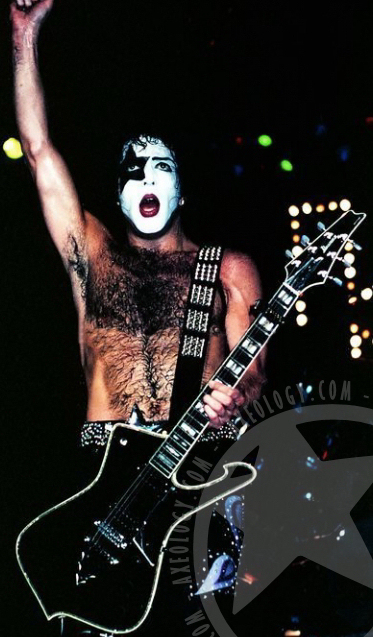
[Left] PS10A with a capo at the 2nd fret for I was made for lovin' you. The manufacturing diligence of Ibanez evidently wasn't what Paul expected at the time so the two backup PS10's were unceremoniously dumped about 2/3 into the tour in favor of two Hamers.
SM#1 continued doing the heavy lifting for Paul but there were apparently a few things that didn't sit right. This pic, which is from Buffalo, NY on August 8, show three changes to SM#1. The changes may have happened around August 4 as there are no known photos from the show in Toronto, Ontario where Paul uses SM#1, the only known 1979 show where that happens. Since it's a better pic I'll use Cincinnati, OH on September 14 (right) to detail the three changes that appear. The first one is easy to see as long as the headstock is visible: SM#1 has gotten new tuning pegs. Instead of the "notched" heads of the production PS10 we see the same square pearloid Grover Rotomatic "milk bottle" tuners previously seen on the backup PS10 and Ace's Les Pauls.
Secondly, and not as obvious in the pic on the right, the neck pickup has been turned upside down! The adjustable pole pieces, previously towards the bridge, are now towards the neck. Since KISS's music in the live setting was about as subtle as a sledge hammer on steroids and Paul probably used his neck pickup only slightly more than never, it is a truly curious modification. Unless the guitar was disassembled for regular maintenance work, which is not entirely improbable as the dry ice smoke used on stage could wreak havoc on controls and pickups in the long run, there was really no reason to even touch the neck pickup.
Thirdly, the nut has been changed. This is somewhat conjectural but I'll stick my neck out and say that the new nut is a half bone/half brass nut as seen on the original production PS10 and not just a regular bone nut. Since I have no ridiculous-resolution pics to back this up I base this mostly on the appearance of the nut later on and the simple fact that I can't say either way.
Secondly, and not as obvious in the pic on the right, the neck pickup has been turned upside down! The adjustable pole pieces, previously towards the bridge, are now towards the neck. Since KISS's music in the live setting was about as subtle as a sledge hammer on steroids and Paul probably used his neck pickup only slightly more than never, it is a truly curious modification. Unless the guitar was disassembled for regular maintenance work, which is not entirely improbable as the dry ice smoke used on stage could wreak havoc on controls and pickups in the long run, there was really no reason to even touch the neck pickup.
Thirdly, the nut has been changed. This is somewhat conjectural but I'll stick my neck out and say that the new nut is a half bone/half brass nut as seen on the original production PS10 and not just a regular bone nut. Since I have no ridiculous-resolution pics to back this up I base this mostly on the appearance of the nut later on and the simple fact that I can't say either way.
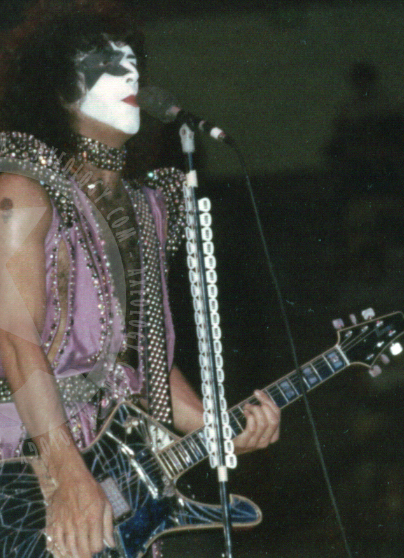

The neck pickup stayed "inverted" for the remainder of the tour. The tuners, however, weren't so lucky. Paul evidently didn't care for the square "milk bottle" tuners (but more on those later) and they were replaced by classic Schaller M6's by September 22 in Chicago, IL as seen in the pic on the left.
For the remaining three months of touring SM#1 gets a break from modifications but not the workload; despite the addition of the Hamers and the Gibson Explorer II (which seems to have done capo duty for I was made for lovin' you) SM#1 gets the nod and is the undisputed no. 1. Just as an excuse to post some cool pics we see it in Norman, OK on October 17; in Vancouver, BC on November 19; and on November 27 in Fresno, CA.
The changes made to SM#1 would, for the most part, prove lasting. In fact, in the extended career of KISS this is probably the one guitar he has cherished the most.
For the remaining three months of touring SM#1 gets a break from modifications but not the workload; despite the addition of the Hamers and the Gibson Explorer II (which seems to have done capo duty for I was made for lovin' you) SM#1 gets the nod and is the undisputed no. 1. Just as an excuse to post some cool pics we see it in Norman, OK on October 17; in Vancouver, BC on November 19; and on November 27 in Fresno, CA.
The changes made to SM#1 would, for the most part, prove lasting. In fact, in the extended career of KISS this is probably the one guitar he has cherished the most.
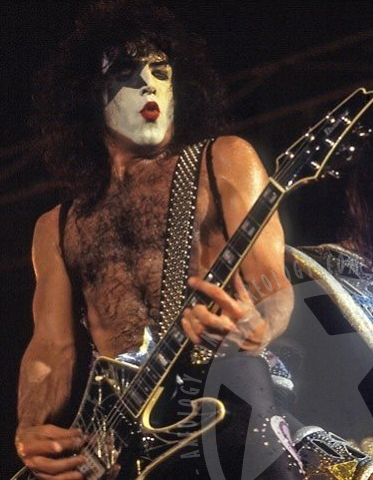


[Left] SM#1 in its last incarnation during the Return of KISS Tour. The change to Schaller M6 tuning pegs would be the last change and provide a swansong of sorts.
The first real action for any of Paul's guitars in 1980, which by KISS's standards was another slow year touring-wise, was a Waring Abbott photo shot on May 22. For this shoot Paul brought two PS10's, one with the production model "notched" Velve-Tune tuning pegs (as seen on the right) and one with chrome tuning pegs, probably Schaller M6. Other than that both guitars appear to be stock production models which makes sense since he had effectively stopped using them 8 months earlier.
(One could make the case that the Velve-Tune-equipped PS10 here is actually PS10B, and evidence appearing later might suggest that it was, but the events surrounding the use of the PS10's during the previous tour and way the story unfolds after this photo shoot suggests a simpler explanation: the guitars were supplied by Ibanez for the shoot.)
(One could make the case that the Velve-Tune-equipped PS10 here is actually PS10B, and evidence appearing later might suggest that it was, but the events surrounding the use of the PS10's during the previous tour and way the story unfolds after this photo shoot suggests a simpler explanation: the guitars were supplied by Ibanez for the shoot.)
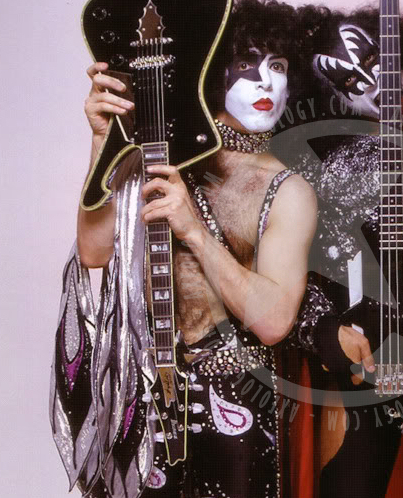
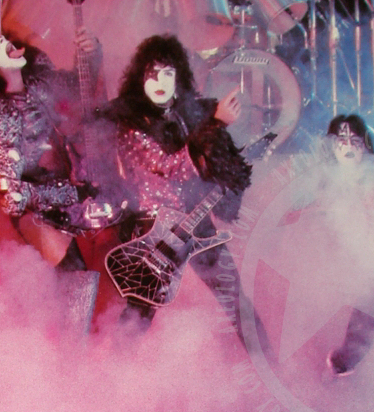
For the promo shots taken before the show at the Palladium on July 25, some of which were later used for the Unmasked tour book, Paul showed up with a second cracked mirror PS10 (SM#2). This one, also modified by Jeff Hasselberger, had much larger pieces of mirror and came with the production model "notched" tuning pegs, the 21st fret name inlay, but, like the beloved SM#1, single-layer binding on the headstock. Also quite unlike SM#1 it had the knobs spaced wider like the production model. Two more details make it stand out. First, SM#1 had a black plastic truss rod cover but SM#2 has a mirror truss rod cover but one which differs from the production model PS10 in that it lacks a signature. SM#2 came equipped with EMG pickups, probably as a result of Paul using EMG-equipped Hamers for the latter part of the Return of KISS Tour. (At this stage we don't know for sure but I will assume that SM#1 retained its DiMarzio/Ibanez pickup combo.) These EMG's were the early kind with the large relief logo rather than the small white print logo that later became common with the introduction of the EMG81.
One small detail that SM#2 had in common with SM#1 was that the nut was (and still is) brass. Since Paul had the nut of the SM#1 changed during the course of the Return of KISS Tour it seems odd that SM#2, if it was built later than SM#1, retained this design element. And as far as I know, Paul has never stated anything about the timeline of these two guitars. "There were two 'Shattered Mirror' Paul Stanley models." (GTRTW, 1996) Despite having nothing than this weak logic argument to back it up I have a hunch that both guitars were made by Hasselberger at about the same time, the only difference having been that SM#2 was actually based on a production model PS10.
Although not immediately obvious, this wasn't SM#2's first showing - it was used for the filming of the Shandi promo video in June. The body of the guitar isn't visible enough to distinguish it from SM#1 but the headstock shows the production model "notched" tuning pegs, a feature that SM#1 lost in August of 1979.
As far as public appearances go, that was it for SM#2. There are no live shots of it from the Unmasked Tour and after 1980 the PS10's were all out of fashion as far as Paul was concerned. In 1996 Paul hinted that it had been stolen: "There were two "Shattered Mirror" Paul Stanley Models. […] I still have one of them, the other one is with the Rhinestone V, the black V, all those guitars…" (GTRTW, 1996) SM#1 was still in Paul's possession as late as 2010, it was pictured in the June 2010 issue of Guitar Aficionado, so that's obviously the one he still has (or at least had). SM#2 currently resides in the collection at the Victoria & Albert Museum in London, England and according to their web site the guitar was a gift for the collection by KISS via Press Office Ltd. which suggests that Paul was either mistaken in 1996 or that the guitar, if stolen, was returned to the band some time thereafter and then given to the museum collection.
Although not immediately obvious, this wasn't SM#2's first showing - it was used for the filming of the Shandi promo video in June. The body of the guitar isn't visible enough to distinguish it from SM#1 but the headstock shows the production model "notched" tuning pegs, a feature that SM#1 lost in August of 1979.
As far as public appearances go, that was it for SM#2. There are no live shots of it from the Unmasked Tour and after 1980 the PS10's were all out of fashion as far as Paul was concerned. In 1996 Paul hinted that it had been stolen: "There were two "Shattered Mirror" Paul Stanley Models. […] I still have one of them, the other one is with the Rhinestone V, the black V, all those guitars…" (GTRTW, 1996) SM#1 was still in Paul's possession as late as 2010, it was pictured in the June 2010 issue of Guitar Aficionado, so that's obviously the one he still has (or at least had). SM#2 currently resides in the collection at the Victoria & Albert Museum in London, England and according to their web site the guitar was a gift for the collection by KISS via Press Office Ltd. which suggests that Paul was either mistaken in 1996 or that the guitar, if stolen, was returned to the band some time thereafter and then given to the museum collection.

[Above] SM#2 in July 1980. Photos from the session were used for the 1980 Tour Book (one became the cover) even though the guitar was never used live.
[Right] SM#2 currently resides in the collection of the V&A museum in London. Unfortunately it's not part of any of the permanent displays.
For the Unmasked Tour there are virtually no pictures of any PS10, the one possible exception being a poor-quality pic supposedly from Hamburg, Germany where it's used for the "kneeling" part in Black Diamond. Although it's not an out-and-out disowning of the PS10 and his involvement with Ibanez, the following quote from Sounds speaks volumes about Paul's attitude towards a guitar he had "designed" and the company who built it. "Neither one of us is really tied in with anything per se; I play stuff like Hamers, I play the Ibanez… actually at the moment I'm playing Hamers pretty much exclusively, not because I have to but because they're my favourite at the moment." (Sounds, October 1980) Several years later he talked more openly about the split with Ibanez. "For a while there [1982-1992] we stopped making them, because at one point I didn't think that Ibanez was living up to their end of the deal which was to always make the guitar we agreed to make. If a guitar is painted black, you can sometimes put something underneath that isn't what should be there." (GTRTW, 1996)

